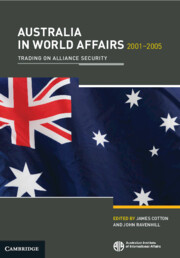Book contents
- Frontmatter
- Contents
- Illustrations
- Contributors
- Preface
- Abbreviations
- Part 1 The Foreign Policy Scene
- Part 2 Relationships
- 2 Extreme Allies: Australia and the USA
- 3 Rebuilding Engagement: Australia and South-East Asia
- 4 Australia and Japan: Challenges and Opportunities
- 5 Australia and China: Towards a Strategic Partnership?
- 6 Australia, Britain, and the European Union
- 7 Australia and Fragile States in the Pacific
- 8 Perfect Strangers: Australia and West Asia
- Part 3 Issues
- Part 4 Foreign Policy in the Political Process
- Survey Sources
- References
- Index
3 - Rebuilding Engagement: Australia and South-East Asia
from Part 2 - Relationships
Published online by Cambridge University Press: 04 May 2024
- Frontmatter
- Contents
- Illustrations
- Contributors
- Preface
- Abbreviations
- Part 1 The Foreign Policy Scene
- Part 2 Relationships
- 2 Extreme Allies: Australia and the USA
- 3 Rebuilding Engagement: Australia and South-East Asia
- 4 Australia and Japan: Challenges and Opportunities
- 5 Australia and China: Towards a Strategic Partnership?
- 6 Australia, Britain, and the European Union
- 7 Australia and Fragile States in the Pacific
- 8 Perfect Strangers: Australia and West Asia
- Part 3 Issues
- Part 4 Foreign Policy in the Political Process
- Survey Sources
- References
- Index
Summary
The prospects for Australia’s relations with its most immediate region at the beginning of the decade seemed bleak indeed. On the surface at least, they continued to be troubled as the rise of terrorism and people smuggling as major security issues, and Australia’s participation in the 2003 invasion of Iraq, introduced new sources of tension into Australia’s relations with its northern neighbours. Yet by 2005 the picture had changed remarkably. John Howard’s government, despite being dogged by diplomatic gaffes and pilloried by its critics, had achieved some remarkable successes in Australia’s relations with South-East Asia. Bilateral trade agreements had been signed or were under negotiation with the region’s major economies. Talks had begun on a new security agreement with Indonesia, and the Australian Prime Minister seemed to have forged a close rapport with the first directly elected Indonesian President. Perhaps most significantly, Howard was invited to two meetings crucial to the development of a new East Asian regional institution: the Association of South-East Asian Nations (ASEAN) Summit in November 2004 and the inaugural East Asia Summit in December 2005.
Keywords
- Type
- Chapter
- Information
- Australia in World Affairs 2001–2005Trading on Alliance Security, pp. 45 - 60Publisher: Cambridge University PressFirst published in: 2024

